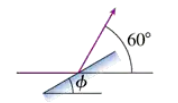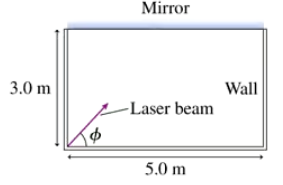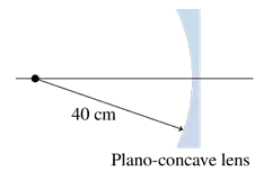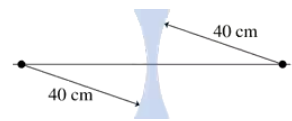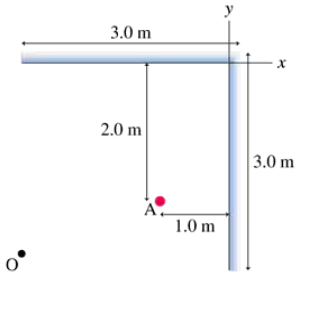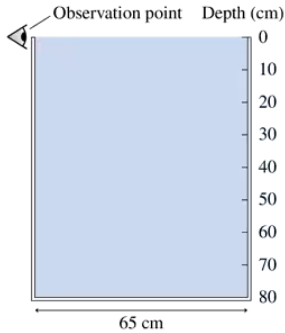 Back
BackProblem 1b
What distance does light travel in water, glass, and cubic zirconia during the time that it travels 1.0 m in vacuum?
Problem 2
A point source of light illuminates an aperture 2.0 m away. A 12.0-cm-wide bright patch of light appears on a screen 1.0 m behind the aperture. How wide is the aperture?
Problem 3
A student has built a 15-cm-long pinhole camera for a science fair project. She wants to photograph her 180-cm-tall friend and have the image on the film be 5.0 cm high. How far should the front of the camera be from her friend?
Problem 4
A 5.0-cm-thick layer of oil is sandwiched between a 1.0-cm-thick sheet of glass and a 2.0-cm-thick sheet of polystyrene plastic. How long (in ns) does it take light incident perpendicular to the glass to pass through this 8.0-cm-thick sandwich?
Problem 5
The mirror in FIGURE EX34.5 deflects a horizontal laser beam by 60°. What is the angle ϕ?
Problem 6
At what angle ϕ should the laser beam in FIGURE EX34.6 be aimed at the mirrored ceiling in order to hit the midpoint of the far wall?
Problem 8
When you look into your car's 5.0-cm-tall rear-view mirror from 35 cm away, the front of a bus, from the ground to the roof, exactly fills the mirror. If the bus is 17 m from the mirror, how tall is the bus?
Problem 9
It is 165 cm from your eyes to your toes. You're standing 200 cm in front of a tall mirror. How far is it from your eyes to the image of your toes?
Problem 10
A 1.0-cm-thick layer of water stands on a horizontal slab of glass. A light ray in the air is incident on the water 60° from the normal. What is the ray's direction of travel in the glass?
Problem 12
A costume jewelry pendant made of cubic zirconia is submerged in oil. A light ray in the oil strikes one face of the zirconia crystal at an angle of incidence of 25°. Once inside, what is the ray's angle with respect to the face of the crystal?
Problem 13
The glass core of an optical fiber has an index of refraction 1.60. The index of refraction of the cladding is 1.48. What is the maximum angle a light ray can make with the wall of the core if it is to remain inside the fiber?
Problem 14
An underwater diver sees the sun 50° above horizontal. How high is the sun above the horizon to a fisherman in a boat above the diver?
Problem 17
A biologist keeps a specimen of his favorite beetle embedded in a cube of polystyrene plastic. The hapless bug appears to be 2.0 cm within the plastic. What is the beetle's actual distance beneath the surface?
Problem 19
To a fish in an aquarium, the 4.00-mm-thick walls appear to be only 3.50 mm thick. What is the index of refraction of the walls?
Problem 20
A giant ocean tank at an aquarium has acrylic plastic walls 18 cm thick. The index of refraction of acrylic plastic is 1.49. A fish is 220 cm from the inside wall. To a viewer on the outside, how far does the fish appear to be from the outside wall? Hint: The of the first refraction is the object for the second refraction.
Problem 22
An object is 20 cm in front of a converging lens with a focal length of 10 cm. Use ray tracing to determine the location of the image. Is the upright or inverted?
Problem 25
Find the focal length of the plano-concave polystyrene plastic lens in FIGURE EX34.25.
Problem 28
Find the focal length of the glass lens in FIGURE EX34.28.
Problem 30
A goldfish lives in a 50-cm-diameter spherical fish bowl. The fish sees a cat watching it. If the cat's face is 20 cm from the edge of the bowl, how far from the edge does the fish see it as being? (You can ignore the thin glass wall of the bowl.)
Problem 31
A 1.0-cm-tall candle flame is 60 cm from a lens with a focal length of 20 cm. What are the distance and the height of the flame's image?
Problem 32b
A 1.0-cm-tall object is 10 cm in front of a converging lens that has a 30 cm focal length. Calculate the image position and height. Compare with your ray-tracing answers in part a.
Problem 34
A laser beam in air is incident on a liquid at an angle of 53° with respect to the normal. The laser beam's angle in the liquid is 35°. What is the liquid's index of refraction?
Problem 35
A 2.0-cm-tall object is 15 cm in front of a plano-convex polystyrene plastic lens that has a 13 cm radius of curvature. What are the (a) position and (b) height of the image?
Problem 36a
A 1.0-cm-tall object is 60 cm in front of a diverging lens that has a −30 cm focal length. Use ray tracing to find the position and height of the image. To do this accurately, use a ruler or paper with a grid. Determine the image distance and image height by making measurements on your diagram.
Problem 40
An object is 12 cm in front of a concave mirror with a focal length of 20 cm. Use ray tracing to locate the image. Is the image upright or inverted?
Problem 43
An advanced computer sends information to its various parts via infrared light pulses traveling through silicon fibers. To acquire data from memory, the central processing unit sends a light-pulse request to the memory unit. The memory unit processes the request, then sends a data pulse back to the central processing unit. The memory unit takes 0.5 ns to process a request. If the information has to be obtained from memory in 2.0 ns, what is the maximum distance the memory unit can be from the central processing unit?
Problem 44b
A red ball is placed at point A in FIGURE P34.44. What are the (x, y) coordinates of each image?
Problem 46
The place you get your hair cut has two nearly parallel mirrors 5.0 m apart. As you sit in the chair, your head is 2.0 m from the nearer mirror. Looking toward this mirror, you first see your face and then, farther away, the back of your head. (The mirrors need to be slightly nonparallel for you to be able to see the back of your head, but you can treat them as parallel in this problem.) How far away does the back of your head appear to be? Neglect the thickness of your head.
Problem 47a
A light ray in air is incident on a transparent material whose index of refraction is n. Find an expression for the (non-zero) angle of incidence whose angle of refraction is half the angle of incidence.
Problem 48a
The 80-cm-tall, 65-cm-wide tank shown in FIGURE P34.48 is completely filled with water. The tank has marks every 10 cm along one wall, and the 0 cm mark is barely submerged. As you stand beside the opposite wall, your eye is level with the top of the water. Can you see the marks from the top of the tank (the 0 cm mark) going down, or from the bottom of the tank (the 80 cm mark) coming up? Explain.

